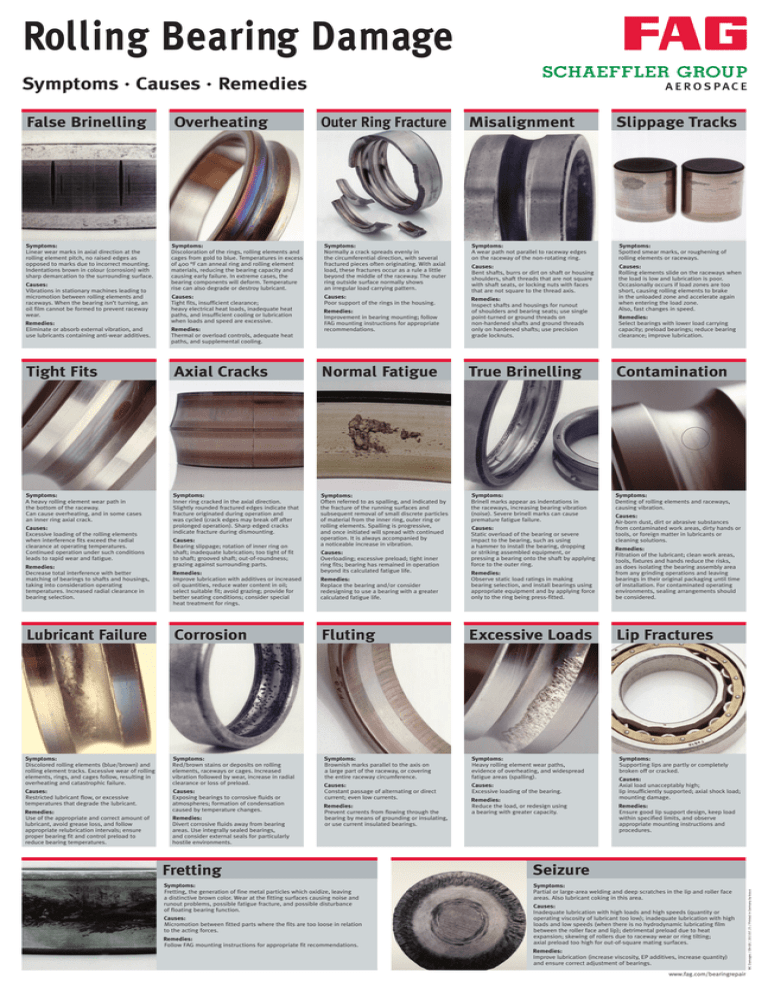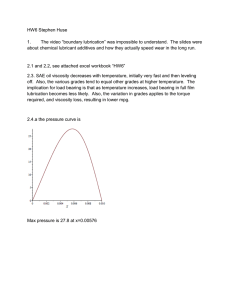Rolling Bearing Damage: Symptoms · Causes · Remedies
advertisement

Rolling Bearing Damage Symptoms · Causes · Remedies Symptoms: Linear wear marks in axial direction at the rolling element pitch, no raised edges as opposed to marks due to incorrect mounting. Indentations brown in colour (corrosion) with sharp demarcation to the surrounding surface. Causes: Vibrations in stationary machines leading to micromotion between rolling elements and raceways. When the bearing isn’t turning, an oil film cannot be formed to prevent raceway wear. Remedies: Eliminate or absorb external vibration, and use lubricants containing anti-wear additives. Overheating Outer Ring Fracture Symptoms: Normally a crack spreads evenly in the circumferential direction, with several fractured pieces often originating. With axial load, these fractures occur as a rule a little beyond the middle of the raceway. The outer ring outside surface normally shows an irregular load carrying pattern. Symptoms: A wear path not parallel to raceway edges on the raceway of the non-rotating ring. Symptoms: Spotted smear marks, or roughening of rolling elements or raceways. Causes: Bent shafts, burrs or dirt on shaft or housing shoulders, shaft threads that are not square with shaft seats, or locking nuts with faces that are not square to the thread axis. Causes: Tight fits, insufficient clearance; heavy electrical heat loads, inadequate heat paths, and insufficient cooling or lubrication when loads and speed are excessive. Causes: Poor support of the rings in the housing. Remedies: Inspect shafts and housings for runout of shoulders and bearing seats; use single point-turned or ground threads on non-hardened shafts and ground threads only on hardened shafts; use precision grade locknuts. Causes: Rolling elements slide on the raceways when the load is low and lubrication is poor. Occasionally occurs if load zones are too short, causing rolling elements to brake in the unloaded zone and accelerate again when entering the load zone. Also, fast changes in speed. Remedies: Thermal or overload controls, adequate heat paths, and supplemental cooling. Remedies: Improvement in bearing mounting; follow FAG mounting instructions for appropriate recommendations. Axial Cracks Normal Fatigue Symptoms: A heavy rolling element wear path in the bottom of the raceway. Can cause overheating, and in some cases an inner ring axial crack. Symptoms: Inner ring cracked in the axial direction. Slightly rounded fractured edges indicate that fracture originated during operation and was cycled (crack edges may break off after prolonged operation). Sharp edged cracks indicate fracture during dismounting. Symptoms: Often referred to as spalling, and indicated by the fracture of the running surfaces and subsequent removal of small discrete particles of material from the inner ring, outer ring or rolling elements. Spalling is progressive, and once initiated will spread with continued operation. It is always accompanied by a noticeable increase in vibration. Remedies: Decrease total interference with better matching of bearings to shafts and housings, taking into consideration operating temperatures. Increased radial clearance in bearing selection. Causes: Bearing slippage; rotation of inner ring on shaft; inadequate lubrication; too tight of fit to shaft; grooved shaft; out-of-roundness; grazing against surrounding parts. Remedies: Improve lubrication with additives or increased oil quantities, reduce water content in oil; select suitable fit; avoid grazing; provide for better seating conditions; consider special heat treatment for rings. Lubricant Failure Corrosion Symptoms: Discolored rolling elements (blue/brown) and rolling element tracks. Excessive wear of rolling elements, rings, and cages follow, resulting in overheating and catastrophic failure. Symptoms: Red/brown stains or deposits on rolling elements, raceways or cages. Increased vibration followed by wear, increase in radial clearance or loss of preload. Causes: Restricted lubricant flow, or excessive temperatures that degrade the lubricant. Causes: Exposing bearings to corrosive fluids or atmospheres; formation of condensation caused by temperature changes. Remedies: Use of the appropriate and correct amount of lubricant, avoid grease loss, and follow appropriate relubrication intervals; ensure proper bearing fit and control preload to reduce bearing temperatures. Slippage Tracks Symptoms: Discoloration of the rings, rolling elements and cages from gold to blue. Temperatures in excess of 400 °F can anneal ring and rolling element materials, reducing the bearing capacity and causing early failure. In extreme cases, the bearing components will deform. Temperature rise can also degrade or destroy lubricant. Tight Fits Causes: Excessive loading of the rolling elements when interference fits exceed the radial clearance at operating temperatures. Continued operation under such conditions leads to rapid wear and fatigue. Misalignment Remedies: Divert corrosive fluids away from bearing areas. Use integrally sealed bearings, and consider external seals for particularly hostile environments. Causes: Overloading; excessive preload; tight inner ring fits; bearing has remained in operation beyond its calculated fatigue life. Remedies: Replace the bearing and/or consider redesigning to use a bearing with a greater calculated fatigue life. Fluting True Brinelling Symptoms: Brinell marks appear as indentations in the raceways, increasing bearing vibration (noise). Severe brinell marks can cause premature fatigue failure. Causes: Static overload of the bearing or severe impact to the bearing, such as using a hammer to install the bearing, dropping or striking assembled equipment, or pressing a bearing onto the shaft by applying force to the outer ring. Remedies: Observe static load ratings in making bearing selection, and install bearings using appropriate equipment and by applying force only to the ring being press-fitted. Excessive Loads Symptoms: Brownish marks parallel to the axis on a large part of the raceway, or covering the entire raceway circumference. Symptoms: Heavy rolling element wear paths, evidence of overheating, and widespread fatigue areas (spalling). Causes: Constant passage of alternating or direct current; even low currents. Causes: Excessive loading of the bearing. Remedies: Prevent currents from flowing through the bearing by means of grounding or insulating, or use current insulated bearings. Remedies: Reduce the load, or redesign using a bearing with greater capacity. Remedies: Select bearings with lower load carrying capacity; preload bearings; reduce bearing clearance; improve lubrication. Contamination Symptoms: Denting of rolling elements and raceways, causing vibration. Causes: Air-born dust, dirt or abrasive substances from contaminated work areas, dirty hands or tools, or foreign matter in lubricants or cleaning solutions. Remedies: Filtration of the lubricant; clean work areas, tools, fixtures and hands reduce the risks, as does isolating the bearing assembly area from any grinding operations and leaving bearings in their original packaging until time of installation. For contaminated operating environments, sealing arrangements should be considered. Lip Fractures Symptoms: Supporting lips are partly or completely broken off or cracked. Causes: Axial load unacceptably high; lip insufficiently supported; axial shock load; mounting damage. Remedies: Ensure good lip support design, keep load within specified limits, and observe appropriate mounting instructions and procedures. Fretting Seizure Symptoms: Fretting, the generation of fine metal particles which oxidize, leaving a distinctive brown color. Wear at the fitting surfaces causing noise and runout problems, possible fatigue fracture, and possible disturbance of floating bearing function. Symptoms: Partial or large-area welding and deep scratches in the lip and roller face areas. Also lubricant coking in this area. Causes: Micromotion between fitted parts where the fits are too loose in relation to the acting forces. Remedies: Follow FAG mounting instructions for appropriate fit recommendations. Causes: Inadequate lubrication with high loads and high speeds (quantity or operating viscosity of lubricant too low); inadequate lubrication with high loads and low speeds (when there is no hydrodynamic lubricating film between the roller face and lip); detrimental preload due to heat expansion; skewing of rollers due to raceway wear or ring tilting; axial preload too high for out-of-square mating surfaces. Remedies: Improve lubrication (increase viscosity, EP additives, increase quantity) and ensure correct adjustment of bearings. www.fag.com/bearingrepair WC Damages / EN-GB / 201107.25 / Printed in Germany by kraus False Brinelling

